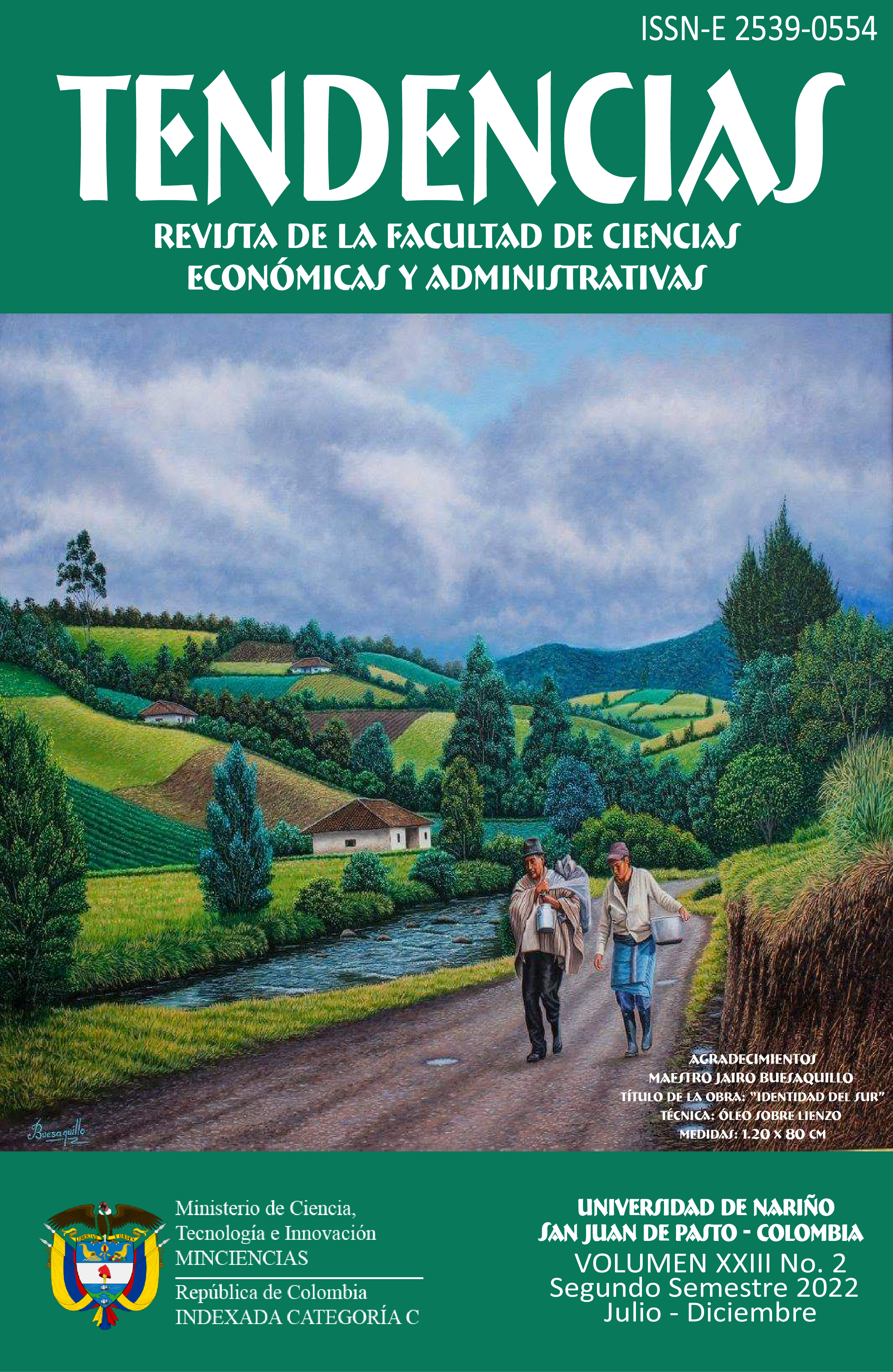Experimental audiovisual production with students of the University of Nariño: analysis of the creative Process
DOI:
https://doi.org/10.22267/rtend.222302.212Keywords:
university cathedra, university students, filming, creative processes, experimental videoAbstract
Pasto is an artistic-artisanal city by nature, taking into account the creative environment by which it is influenced, for thisreason, it is important to identify which creative processes are developed in students in the "VisualizARTE: Audiovisual Expression of Being" at the University of Nariño, when creating experimental videos, being this a space where you can bias and differ the rules established by the cinema, where the purpose is only aesthetic and commercial; the experience of teaching the VisualizARTE chair previously, shows that students during six months can strengthen their creation processes, likewise, several studies point out that the constant immersion in an area of creation from the context can be very useful to develop their individual and autonomous creative processes. In this way, a hermeneutic phenomenological analysis of the students' personal experiences will be made to obtain a subjective vision of the process of making their experimental videos, deepening in the essential meanings of the pedagogical experiences of the professorship; proposing the identification of the creative processes developed during the making of experimental videos, as a contribution to future research focused on the same subject with university students.
Downloads
References
(1) Aguilera, A. (2016). El concepto de creatividad a lo largo de la historia. Psicología y mente. https://psicologiaymente.com/inteligencia/creatividad-historia
(2) Amegan, S. (1993). Para una pedagogía activa y creativa. Trillas.
(3) Ayala, R. (2008). La metodología fenomenológico-hermenéutica de M. Van Manen en el campo de la investigación educativa. Posibilidades y primeras experiencias. Revista de Investigación Educativa, 26(2), 409–430.
(4) Barahona, A. (2005). Galton y el surgimiento de la genética humana. Ludus Vitalis, 23(23), 151–162. http://ludus-vitalis.org/html/textos/23/23-10_barahona.pdf
(5) Bravo, C. M. (2009). Como estimular la creatividad en educación. Revista INFAD de Psicología. International Journal of Developmental and Educational Psychology, 2(1), 89-97. https://www.redalyc.org/articulo.oa?id=349832321009
(6) Carretero, M. y Fairstein, G. (2001). La teoría de Jean Piaget y la educación. Medio siglo de debates y aplicaciones. En J. Trilla (Ed.), El legado pedagógico del siglo XX para la escuela del siglo XXI (pp. 177-205). Editorial Graó.
(7) Cossio, J. (2016). Pedagogías y didácticas críticas latinoamericanas: la obra de Paulo Freire y Estela Quintar. [Tesis de maestría, Universidad de Medellín]. Repositorio Institucional Universidad de Medellín. https://repository.udem.edu.co/bitstream/handle/11407/3492/T_ME_18.pdf
(8) De Bono, E. (1988). Seis sombreros para pensar. Ediciones Paidós.
(9) Deslauriers, J. (2004). Investigación cualitativa: guía práctica. Papiro. https://repositorio.utp.edu.co/server/api/core/bitstreams/77bc824c-c999-4ae7-b185-ce6d2e80d8af/content
(10) Fernández, J. (2001). Paulo Freire y la educación liberadora. En J. Trilla (Ed.), El legado pedagógico del siglo XX para la escuela del siglo XXI (pp. 313-342). Editorial Graó.
(11) Freire, P. (1970). Pedagogía del Oprimido. Siglo XXI editores. https://fhcv.files.wordpress.com/2014/01/freire-pedagogia-del-oprimido.pdf
(12) Fuster, D. (2019). Investigación cualitativa: Método fenomenológico hermenéutico. Propósitos y Representaciones, 7(1), 201-229. https://doi.org/10.20511/PYR2019.V7N1.267
(13) García, A. y Gálvez, A. (2014). Redefiniendo el videoarte: orígenes, límites y trayectorias de una hibridación en el panorama de la creación audiovisual española contemporánea. Revista ICONO14 Revista Científica de Comunicación y Tecnologías Emergentes, 12(2), 86–112. https://doi.org/10.7195/ri14.v12i2.707
(14) Gardner, H. (1982). Arte mente y cerebro. Ediciones Paidos.
(15) Goleman, D., Kaufman, P. y Ray, M. (2009). El Espíritu creativo. B.S.A.
(16) Gonzales, P. y Carmona, A. (2000). Vídeo creación: (llámese vídeo experimental ó vídeo arte) como generador de aprendizaje [Tesis de Pregrado, Corporación universitaria autónoma de occidente]. Repositorio educativo digital Universidad Autónoma de Occidente. http://red.uao.edu.co/bitstream/10614/5440/1/TCS01821.pdf
(17) Guilera, L. (2011). Anatomía de la creatividad. Fundit.
(18) Guilford, J. (1978). Creatividad y Educación. Paidos.
(19) Kant, I. (1781). Crítica de la razón pura. Taurus.
(20) López, O., Prieto, M. y Hervás, R. (1998). Creatividad, superdotación y estilos de aprendizaje: hacia un modelo integrador. FAISCA. Revista de Altas Capacidades, (6), 86–108. https://dialnet.unirioja.es/servlet/articulo?codigo=2476212
(21) Ortiz, D. (2015). El constructivismo como teoría y método de enseñanza. Sophia, 19(2), 93–110. https://doi.org/10.17163/soph.n19.2015.04
(22) Ortiz, M. (2018). Producción y realización en medios audiovisuales. RUA. Universidad de Alicante.
(23) Penagos, J. y Aluni, R. (2000). Creatividad, una aproximación. Revista Psicología, (Número especial), 3-11. http://inteligenciacreatividad.com/recursos/revista-psicologia/revista-psicologia-2/index.html
(24) Penalva, C., Alaminos, A., Francés, F. y Santacreu, Ó. (2015). La investigación cualitativa: técnicas de investigación y análisis con Atlas.ti. PYDLOS Ediciones.
(25) Real Academia Española. (s.f.). Video. Diccionario de la lengua española. https://dle.rae.es/video?m=form
(26) Rojas, E. (2016). Las 12 Musas de la Creatividad. Posgrados y Educación Ejecutiva del Tecnológico de Monterrey. https://educacionejecutivablog.wordpress.com/2016/02/03/las-12-musas-de-la-creatividad/
(27) Sternberg, R. (1990). Más allá́ del cociente intelectual: una teoría triárquica de la inteligencia humana. Desclée De Brouwer.
(28) Torrance, E. P. (1962). Guiding creative talent. Prentice-Hall, Inc. https://doi.org/10.1037/13134-000
(29) Tünnermann, C. (2011). El constructivismo y el aprendizaje de los estudiantes. Revista Universidades, (48), 21–32. https://www.redalyc.org/pdf/373/37319199005.pdf
(30) Vivares, J. (2016). El video-arte / experimental. [Archivo PDF]. https://www.ismjh.com/TrabajosAcademicos/El_Video_Arte_Experimental.pdf
Downloads
Additional Files
Published
How to Cite
Issue
Section
License
Those authors who have publications with this journal, accept the following terms:
This journal is licensed under a Creative Commons Reconocimiento-NoComercial 4.0 Internacional License. The articles can be copied, distributed, adapted and communicated publicly, as long as the credits of the work are recognized and the respective source is quoted. This work can not be used for commercial purposes.
To increase their visibility, documents are sent to databases and indexing systems.
The content of the items is the responsibility of each author, and does not compromise in any way, journal or institution.







































